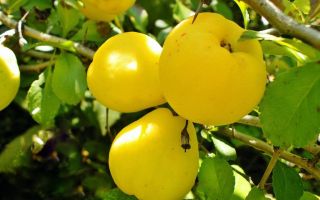Content
- 1 What is quince and what does it look like
- 2 Chemical composition and calorie content of quince
- 3 Why is quince useful for the body
- 4 Quince during pregnancy and breastfeeding
- 5 At what age can quince be children
- 6 Is quince good for weight loss
- 7 Useful properties of leaves, bark and seeds of quince
- 8 Traditional medicine recipes with quince
- 9 The use of quince in cosmetology
- 10 Daily intake
- 11 What can be made from quince
- 12 Harm of quince and contraindications
- 13 How to choose and store quince
- 14 Conclusion
The benefits and harms of quince are of interest to those who want to eat not only tasty, but also healthy food. Although quince is not the most common fruit on store shelves, it is very interesting to understand the properties.
What is quince and what does it look like
Quince trees grow wild and cultivated mainly in the southern regions - in Azerbaijan, the Caucasus, the Mediterranean, hot regions of Asia, Australia, Africa and South America. The trees reach a height of about 5 m, and the fruits bear round, bright yellow, similar to apples.
Unripe fruits are usually covered with villi, but are almost smooth by the time they are fully ripe. The flesh of quince is yellow, resembles an apple in structure, but it is more firm, dense and dry.
Chemical composition and calorie content of quince
This unusual fruit is appreciated not only for its original tart taste with noticeable acidity. The benefits and harms of quince for the body are due to its chemical composition. The fruit contains:
- significant amounts of iron, potassium and sodium;
- phosphorus, magnesium and calcium;
- glucose;
- tartaric, malic and citric acids;
- pectin and fructose;
- tanning components;
- vitamins B - B1, B6, B2 and B3;
- nicotinic acid PP;
- vitamins A, C and E.
The calorie content of the fruit is low - 100 g of pulp contains only 48 calories.

Why is quince useful for the body
The valuable components present in the composition of quince endow it with very useful properties. Specifically, this fruit:
- has a healing effect on colds, bronchitis, coughs, ear pain and sore throat;
- is an excellent prevention of colds due to the wide presence of vitamins;
- regulates blood pressure, protects blood vessels and improves heart function;
- helps to get rid of hemorrhoids;
- serves as a good choleretic and diuretic, relieves swelling;
- helps to cope with nausea and vomiting, stops diarrhea and improves the digestive process;
- assists in the treatment of gastritis and stomach ulcers, helps with diseases of the gums and teeth;
- possesses hematopoietic properties, therefore it is recommended for use in case of anemia;
- stops bleeding;
- has a beneficial effect on the nervous system, relieving feelings of anxiety and tension, tones up and improves mood;
- has a good effect on the condition of the skin - accelerates the process of cell regeneration, has a slight rejuvenating effect, promotes healing of burns and wounds.

The benefits of quince for men
The use of the fruit strengthens the blood vessels and the heart of men, which means that it reduces the risk of heart attacks and strokes, to which the stronger sex is especially predisposed.Also, the fruit helps to cure the inflammatory processes of the genitourinary system, protects the prostate gland from malignant tumors.
Why is quince useful for women
In addition to the fact that the use of quince has a positive effect on the appearance, this fruit also improves the condition with painful periods and with menopause. The benefit of quince for women is that the fruit replenishes iron stores in the body, stops profuse bleeding, and strengthens blood vessels. Thanks to these properties, natural ailments are more easily tolerated by women - good mood and ability to work remain.
Quince during pregnancy and breastfeeding
During the period of bearing a child, the fruit is one of the most beneficial for women. There is no harm from it, and the useful trace elements in the composition help the child to develop normally and strengthen the mother's body. Other beneficial properties of the fruit are that it helps fight attacks of nausea and removes swelling in the later stages.
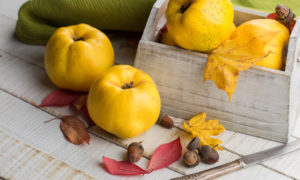
But when breastfeeding, it is better to temporarily remove the fruit from the diet. Quince belongs to the category of exotic products and can be poorly absorbed by the baby's body - the harm manifests itself in the occurrence of allergies, colic and flatulence. In addition, the fruit has a strengthening effect on the intestines - and women after childbirth often suffer from constipation.
At what age can quince be children
Vitamins, trace elements and other valuable substances in the composition of quince can benefit the child. The fruit will contribute to the mental development of the child, strengthen the vascular, cardiac and digestive systems, and will serve as the prevention of viruses and infections.
However, with all the benefits of quince, it is possible to offer an exotic fruit to a child only after 1 year. It rarely causes allergies, but the components present in quince are difficult for babies to digest, and therefore harm to the intestines is possible. When the child turns one year old, you can start acquaintance with quince with compotes, healthy juices or baked pulp.
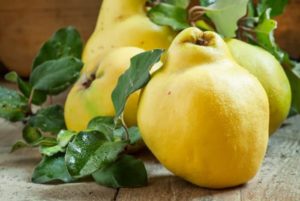
Before offering the baby fresh fruit for the first time, it will need to be peeled - a light fluff on the skin can be harmful, having an irritating effect on the baby's throat. It is necessary to remember about the fixing properties of the fruit. If the child is prone to constipation, then it is better to give up quince altogether.
Is quince good for weight loss
A healthy fruit contains very few calories, there are practically no fats in the composition, and there is no harmful cholesterol in it. All these qualities make quince an ideal product for a dietary diet. If you include the fruit in the list of allowed dishes, there will be no harm, and getting rid of those extra pounds will be faster and easier.
Quince will speed up the metabolism, promote the removal of toxins accumulated in the body. Juices and quince decoctions, fruit-based teas, salads and casseroles with the addition of pulp are very useful on a diet.

Useful properties of leaves, bark and seeds of quince
The value for the body is not only the pulp of the fruit. Other parts of quince - bark, seeds and leaves - also have beneficial properties.
- A large amount of mineral elements is concentrated in the leaves of quince. That is why decoctions and infusions from dried or fresh foliage have such benefits - they supply iron, potassium and phosphorus to the body. Decoctions from the leaves are a powerful natural antiseptic, and they also stop bleeding well.
- In the bark of quince, in addition to vitamins and minerals, there are many tannins. Therefore, drinks based on it have a strong astringent effect. Most often, decoctions and infusions from the bark are used to treat ailments of the mouth area - for example, with periodontal disease, toothache, bleeding gums or traumatic damage to the mucous membrane.
- Plant seeds are a useful natural remedy for constipation. Quince seeds have a mild laxative effect and at the same time act gently, without harming the body. Homemade healthy drinks based on seeds are used for colds - the properties of quince seeds help thin phlegm and help cope with dry coughs.
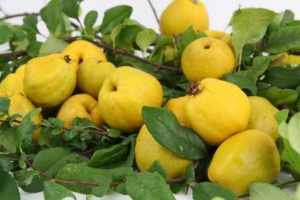
In home medicine, all parts of the fruit plant are used equally - and bring considerable benefits.
Traditional medicine recipes with quince
The beneficial properties of quince can be used for many ailments and chronic ailments. The main thing is to follow the rules for preparing medicinal formulations and the correct dosages so as not to harm yourself.
Infusion of quince leaves
From fresh or dried quince leaves, you can prepare a useful infusion - and it will take very little time. For cooking, the leaves must be chopped in the amount of a tablespoon, then pour a small amount of boiling water and boil for another quarter of an hour. Then the leaves are squeezed out and fresh water is added to them.
The finished infusion can be drunk three times a day, 2 large spoons - better before eating. The benefits of quince leaves are well manifested in colds and bronchitis. The remedy has a positive effect on asthma and even tuberculosis, lowers blood pressure.
In addition, skin lesions can be treated with a beneficial infusion of the leaves. To do this, a piece of gauze or a cotton pad is moistened in the infusion and applied to sore spots for a quarter of an hour.
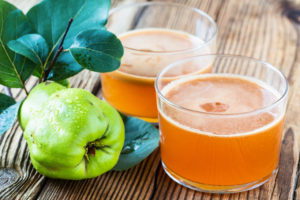
Infusion of quince seeds
The healing drink is prepared as follows:
- a couple of teaspoons of seeds are poured with a glass of warm water;
- for 5 minutes, the infusion is thoroughly mixed, and then left to stand for several hours;
- ready infusion is taken 3 large spoons once a day.
In this case, the seeds should never be crushed or swallowed. They contain amygdalin, a poisonous substance that harms the body. Only intact seeds are safe for use in medicinal infusions.
The seed infusion helps with constipation and restores a healthy bowel movement. Also, the infusion is used for bronchitis, cough, and other respiratory diseases. You need to drink the remedy before meals.
A decoction of quince seeds
Another medically healthy drink is a seed decoction. Pre-dried seeds in the amount of a couple of teaspoons should be poured with a small amount of water, and then cooked until the liquid looks like jelly.

The ready-made broth is consumed little by little - no more than half a glass three times a day. Means:
- helps to get rid of constipation;
- alleviates unpleasant symptoms of gastritis;
- has a beneficial effect on eye diseases;
- helps to eliminate cough;
- promotes rapid healing of skin lesions.
Quince bark broth
A decoction made from the bark of the plant has excellent astringent, anti-inflammatory and analgesic properties. It is prepared like this - a small amount of dried and crushed bark is poured with 1.5 cups of boiling water and boiled for half an hour.
The finished broth is first cooled to a warm state, and then filtered so that the bark itself does not remain in it. Healing agent gargle with sore throat, rinses are useful for periodontal disease and damage to the oral mucosa.
In addition, the astringent properties of the decoction have a beneficial effect on nausea and diarrhea. For rinsing, the agent can be used every couple of hours; it is taken inside a few sips twice a day.
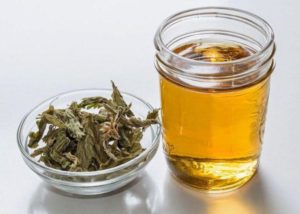
Dried quince decoction
A very useful and vitamin-rich home remedy is a decoction of dried quince.A small amount of dry pulp is poured with a glass of boiling water and boiled for a quarter of an hour, and then allowed to cool and filtered.
The benefits of dried quince are especially great in case of toxicosis - the remedy quickly and for a long time relieves the feeling of nausea. You need to drink the broth in a few sips before eating. Also, the beneficial properties of dried quince help stop internal bleeding - for example, for gynecological ailments. In such cases, only 1 large spoonful of the product per day on an empty stomach is enough.
Quince leaf tea
On the basis of dried and finely chopped quince leaves, you can prepare a fragrant and healthy tea. The classic recipe looks very simple:
- some quince leaves are poured into the teapot;
- add a couple of spoons of your favorite tea leaves to them;
- pour boiling water over the mixture and leave for about 10 minutes.
The finished drink combines the beneficial properties of quince leaves and regular tea. If desired, you can flavor it with honey, add cinnamon or other spices. The benefits of tea from quince leaves will be primarily for digestion and immunity, blood vessels and the nervous system.

Quince syrup
An excellent remedy for anemia is a syrup made from fresh fruit pulp.
- Fresh fruit is cut into small pieces or grated, and then put in a saucepan or enamel bowl.
- The fruit mass is thoroughly sprinkled with sugar - so that it is not only on top or at the bottom, but is thoroughly mixed with the chopped pulp.
- The workpiece is put into the refrigerator for 12 hours - during this time, the fruit pulp will let juice abundantly.
After 12 hours, the quince is removed from the refrigerator, the liquid syrup is filtered through a fine sieve and boiled on the stove for 5 minutes after boiling. Then the syrup is poured into a clean and dry glass container. Store the product in the refrigerator.
In the finished syrup, useful substances are present in a very high concentration - therefore, the remedy helps well with anemia. The syrup quickly restores the reserves of iron and vitamins in the body. Healthy people can also use it as a sweet treat - the syrup will strengthen the immune system and will delight you with a pleasant taste.
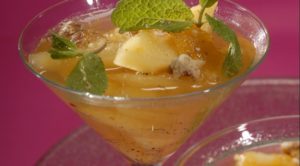
The use of quince in cosmetology
The vitamin composition and valuable properties of quince help to improve the appearance. The fruit has a positive effect on the condition of the hair and nourishes the skin. Quince can be found in commercial cosmetics, but in the same way, the fruit can be used in home beauty recipes.
Facial masks
The fruit not only nourishes the skin and refreshes the face, but also regulates the production of subcutaneous fat and removes wrinkles. Applying the pulp of the fruit is beneficial for treating irritations, acne and excess oiliness, as well as for anti-aging purposes.
The simplest nourishing face mask is fresh pulp crushed into pulp, applied to cleansed skin for a quarter of an hour. Quince can be used in its pure form, or you can add egg yolk or vegetable oil to it.
Quince lotion for aging skin
To start the process of cell renewal, rejuvenate the face and tighten the skin, you need to grate fresh fruit on a fine grater, and then moisten a cotton pad in abundant juice. The product is used to wipe the skin of the face in the morning and shortly before bedtime, you do not need to rinse off the juice.
It is advisable to use a beneficial lotion daily or every other day, on an ongoing basis - then the effect will quickly become apparent.
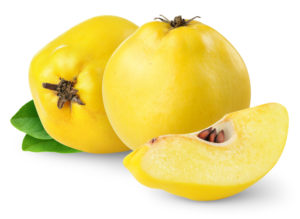
Scrub for face and neck
The fruit can be made into an effective cleansing scrub that will remove dead skin particles. The pulp, carefully chopped on a grater, is mixed with sea salt, and then, with gentle circular movements, it is applied to the face for a couple of minutes. After applying the scrub, the skin should be treated with a moisturizer.
Exotic fruit scrub will leave the skin smooth and soft, and even out its color.
Quince for hair
With the help of decoctions and masks based on fruit, you can adjust the oily curls, get rid of dandruff and even give your hair a darker shade.
- In order to strengthen brittle hair, you need to chop the leaves of the fruit tree and boil them over low heat for 5 minutes. The head is rinsed with the cooled and strained broth after washing. The fruit not only restores strength and shine to the hair, but also makes it a little darker.
- To eliminate dandruff, once a week, a slimy decoction of fruit seeds is rubbed into the skin at the hair roots and the curls themselves. You need to keep the product on your hair until the curls are dry - and then rinse them again with warm water.
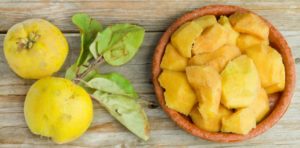
Daily intake
Quince is a fairly safe fruit for health, which rarely causes harm in the absence of contraindications. But the fixing properties of the fruit when overused can lead to constipation. Therefore, the health benefits and harms of quince depend on the daily amount - it is better to limit yourself to 2 quince fruits per day.
What can be made from quince
Not everyone likes fresh quince - the flesh of the fruit is solid, and pronounced sourness prevails in the taste. Therefore, quince is often consumed processed - as part of various dishes.
In particular, fruit compotes and sweet syrups are made from the fruit. Quince is perfect for making jam or jelly - during the heat treatment, it becomes much softer and stops souring. And the benefits of quince jam do not decrease, since the heating does not last long, and the beneficial properties are preserved. The fruit is added to desserts and used in baking, they make marmalade from it and candied fruit.
Quince jam
The benefit of quince jam is that the treat retains most of the vitamins of the fresh fruit. It is done quite simply and quickly, and all that is needed for cooking is the quince fruits themselves, lemon and sugar.
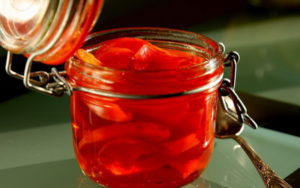
- Several quince fruits are thoroughly washed, dried with a towel, cut in half and all seeds are removed from the core. Then the halves of the fruit are cut into small wedges and poured into a medium-sized saucepan.
- Sugar is poured to the sliced fruits - in approximately equal volumes - and the workpiece is left for 8 hours so that the quince has plenty of juice. For reliability, you can add a glass of water - sometimes the quince pulp is too dry, and the juice is released reluctantly.
- After 8 hours, put the pan with the workpiece on the stove, wait for it to boil and cook for only 5 minutes with constant stirring.
- Then the jam must be removed from the heat and allowed to cool completely, and then put back on the fire and repeat the procedure - and so 2 or 3 times.
Finished quince jam should have a reddish tint, and the fruit slices in it should become transparent.
Before you put the treat to cook for the last time, you need to add lemon - chopped or cut into thin slices. Ready healthy jam is poured into dry sterilized jars, closed with lids and turned upside down. Banks need to be wrapped in blankets and left to cool.
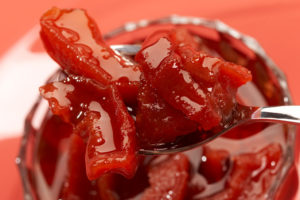
Harm of quince and contraindications
Whatever the benefits of quince, sometimes the fruit can be harmful. Eating exotic yellow fruits is not recommended for:
- individual allergies;
- pleurisy;
- enterocolitis;
- a tendency to constipation.
Quince can negatively affect the larynx and vocal cords - this is safe for ordinary people. But for those who are engaged in vocals or public speaking, it is better to abandon the fruit, or at least give preference to the benefits of candied quince or jam.
It is imperative to remove seeds from fresh fruit - they are harmful in their untreated form, since they contain toxic substances.
How to choose and store quince
When buying a fruit, you need to pay attention to just a few points:
- color of the peel - the fruit should be uniformly yellow, without green spots;
- the density of the quince - dents on the peel, especially darkened and soft, indicate that the fruit has begun to deteriorate;
- lack of blackheads and mold on the surface of the fruit.

You need to store quince in the refrigerator. Before placing the fruit there, it must be washed and dried, a light fluff removed from the surface of the peel and wrapped in plastic wrap. It is better to store the fruits of the quince separately - this way they will retain their freshness and useful properties longer. If there are pears in the refrigerator, then it is better to put the fruit away from them - otherwise the shelf life will be greatly reduced.
If the recommendations are followed, the fruit retains all the benefits for 2 months.
Conclusion
The benefits and harms of quince depend on compliance with the measure when eating the fruit. If, in the absence of contraindications, there are little fruits, quince will not harm health, but will strengthen the body.

